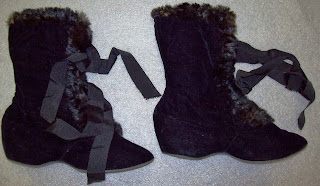From pretty much the beginning of human existence,
we have been wearing fur to stay warm. The museum has a fairly large collection
of items made with fur, from coats and stoles to muffs and fur-lined boots.
Some pieces were made for functionality, like the coat and mittens Ross Marvin wore on his first Arctic expedition, while others were obviously
made only for fashion, like this hat decorated with ermine tails.
 |
| Hat decorated with ermine tails and veil, 1950 |
 |
| Voided velvet cape with fur trim, 1880 |
 |
| Fur-lined carriage boots, 1890s |
 |
| Woman wearing a wide fur stole, 1860s |
The “modern fur coat,” with fur worn on the
outside rather than as a lining, first appeared in the mid-19th century but did
not gain popularity until the early 20th century. In the 1920s, people wore
large, full fur coats to stay warm while traveling in open motorcars. Similarly,
college men wore raccoon coats while attending football games. By the middle of
the century, new techniques of processing and dying furs made it possible for
more people than ever before to own fur coats.
The museum
has collected many pieces of fur, not only because they are examples of
historic fashion but also because of the stories they tell. The
coat pictured below was made by Jesse Green Furrier, Elmira. The donor told the
story of how his wife took pelts that were trapped-locally to Jesse Green to
have them made into a coat. He remembered
her traveling several times to Elmira for fittings while it was being made.
Then she came home with the truly one-of-a-kind, hand-made fur coat.
One other fur in our collection has a very
interesting story that I just learned several weeks ago. This fur pelt brings
us back to arctic explorer, Ross Marvin. The museum has many of his items
including clothing and personal souvenirs from his voyage. Among his things is
what I assumed to be a wolf’s pelt, as there was little documentation in our
records. A short time ago, Kelli came across a 1931 Elmira Star-Gazette article about Marvin’s collection with a list
of items. On that list was “one Eskimo dog skin (taken from a dog eaten by
Marvin on his first expedition to keep from starving.)”






people used different means to keep themselves warm during the cold months wherever they lived, I find it interesting the huge variety of not just coats but shoes, hats, gloves etc were also used.
ReplyDeleteExcellent article. Is it in China that eating dogs is traditional?
ReplyDeleteHello, is there an email of someone who has more information regarding Jesse Green that I could contact? It is for a project I am working on.
ReplyDeleteMany thanks,
Tara
Hi Tara. Our curator's email is curator@chemungvalleymuseum.org.
DeleteTara, Jesse Green is/was my grandfather. I know you wrote the request about finding someone with more info on Jesse Green a couple of years ago, however I am interested in what project you were working on and what information you have. I prefer you use this my email to reach out to me if you like- mtweetie@msn.com
Delete